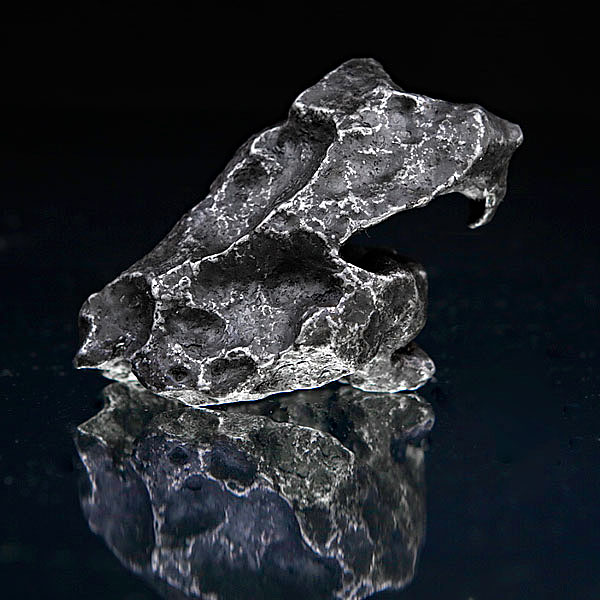|
Roll Overs:
#1
#2
|

|
|
Photos by Christian Meza, Aerolite Meteorites. Copyright (c) Aerolite Meteorites Inc., 2017.
|
346.1 grams. 81 mm x 63 mm x 49 mm Iron, IAB-MG
TKW 50 metric tons. Fall not observed. Found 1576, Argentina.
From Wikipedia:
The Campo del Cielo refers to a group of iron meteorites or to the area where they were found situated on the border between the provinces of Chaco and Santiago del Estero, 1,000 kilometers (620 mi) northwest of Buenos Aires, Argentina. The crater field covers an area of 3×20 kilometers and contains at least 26 craters, the largest being 115×91 meters. The craters' age is estimated as 4,000–5,000 years. The craters, containing iron masses, were reported in 1576, but were already well known to the aboriginal inhabitants of the area. The craters and the area around contain numerous fragments of an iron meteorite. The total weight of the pieces so far recovered exceeds 100 tonnes, making the meteorite the heaviest one ever recovered on Earth. The largest fragment, consisting of 37 tonnes, is the second heaviest single-piece meteorite recovered on Earth, after the Hoba meteorite.
   
Geoff writes:
Good monsoon afternoon fellow Tucsonans,
I have a zoomorphic Campo to contribute: the "Alligator Snapping Turtle"
This remarkable iron is a classic example of just how sculptural iron
meteorites come. From a zoomorphic point of view, we see a very angry
head of an alligator snapping turtle ready to crush with almost as
much power as the Campo del Cielo meteorite impact.
Campo del Cielo is a class IAB iron and an important historic
meteorite. In English, the name means "Field of Heaven" or "Field of
the sky." First discovered in 1576 by Spanish explorers under Captain
de Miravel in Chaco province, Argentina, it is one of Earth's oldest-
known meteorites. The impact is believed to have occurred
approximately 5,600 years ago and the Campo strewnfield is roughly 18
km in length and includes about 25 craters. Campo del Cielo is a
polycrystalline, coarse octahedrite and cut specimens show significant
inclusions of silicate-graphite-trolite.
Visit my Web Site |
Click to view larger photos
#1
#2
|
Found at the arrow (green or red) on the map below
|
|
| |
Chauncey Walden
8/9/2017 7:27:43 AM |
Or, for the old timers out there - Ollie, from Kukla, Fran and Ollie. |
Denis Gourgues
8/8/2017 1:38:41 PM |
.... Snake Space attack.... Psssss.. |
PC
8/8/2017 11:35:20 AM |
"Heavens to Murgatroyd" it is a lion! I can't quite
seem to evoke the turtle though. Great photography,
and a very nice Campo. Thanks |
John Divelbiss
8/8/2017 6:16:16 AM |
The snaggle tooth look of the snapping turtle beak is certainly there to see. Personally I see a naked lady or a possible bottle opener... :/ |
John Hope
8/8/2017 12:37:45 AM |
Snapping turtle Geoff?. I can see a lions head with the large canine tooth, what an amazing large individual piece. Thanks for sharing. |
| |
|